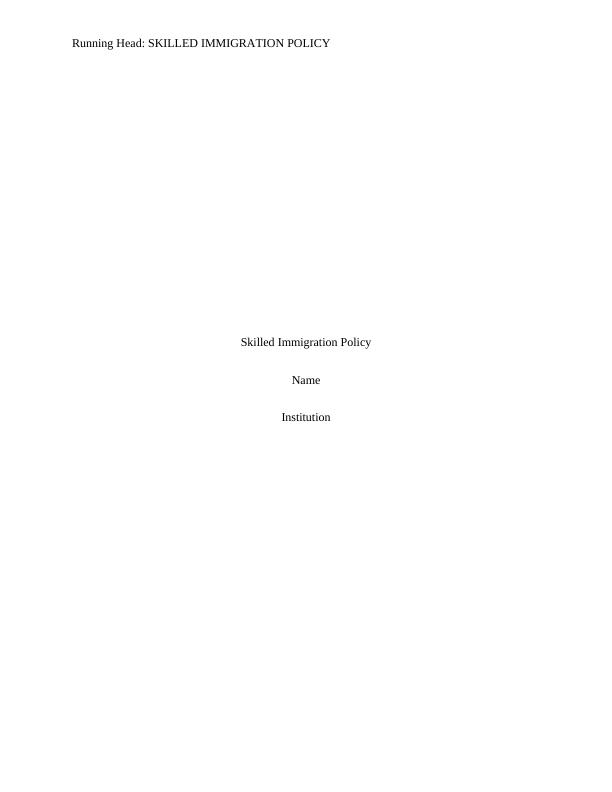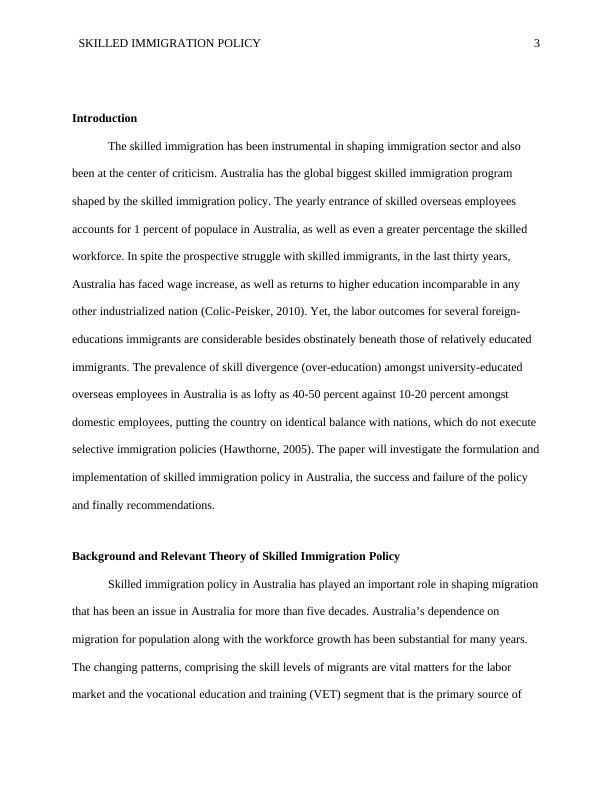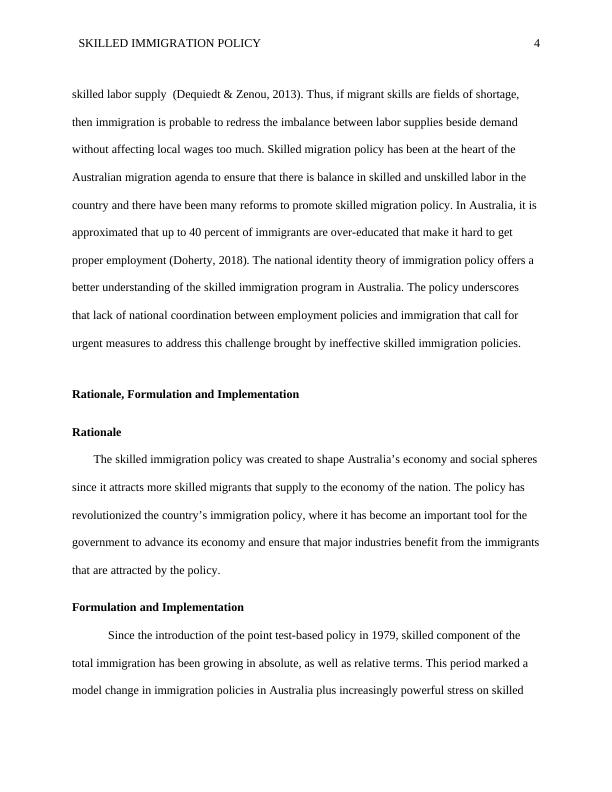SOC103A - Developing Social Policy
Added on 2021-11-12
13 Pages2945 Words20 Views
Running Head: SKILLED IMMIGRATION POLICY
Skilled Immigration Policy
Name
Institution
Skilled Immigration Policy
Name
Institution

SKILLED IMMIGRATION POLICY 2
Skilled Immigration Policy
Table of Contents
Introduction......................................................................................................................................3
Background and Relevant Theory of Skilled Immigration Policy..................................................3
Rationale, Formulation and Implementation...................................................................................4
Rationale......................................................................................................................................4
Formulation and Implementation.................................................................................................4
Critical Success and Failure of the Policy.......................................................................................5
Success of the Policy....................................................................................................................5
Failure of the Policy.....................................................................................................................7
Recommendations............................................................................................................................8
Conclusions....................................................................................................................................10
References......................................................................................................................................11
Skilled Immigration Policy
Table of Contents
Introduction......................................................................................................................................3
Background and Relevant Theory of Skilled Immigration Policy..................................................3
Rationale, Formulation and Implementation...................................................................................4
Rationale......................................................................................................................................4
Formulation and Implementation.................................................................................................4
Critical Success and Failure of the Policy.......................................................................................5
Success of the Policy....................................................................................................................5
Failure of the Policy.....................................................................................................................7
Recommendations............................................................................................................................8
Conclusions....................................................................................................................................10
References......................................................................................................................................11

SKILLED IMMIGRATION POLICY 3
Introduction
The skilled immigration has been instrumental in shaping immigration sector and also
been at the center of criticism. Australia has the global biggest skilled immigration program
shaped by the skilled immigration policy. The yearly entrance of skilled overseas employees
accounts for 1 percent of populace in Australia, as well as even a greater percentage the skilled
workforce. In spite the prospective struggle with skilled immigrants, in the last thirty years,
Australia has faced wage increase, as well as returns to higher education incomparable in any
other industrialized nation (Colic-Peisker, 2010). Yet, the labor outcomes for several foreign-
educations immigrants are considerable besides obstinately beneath those of relatively educated
immigrants. The prevalence of skill divergence (over-education) amongst university-educated
overseas employees in Australia is as lofty as 40-50 percent against 10-20 percent amongst
domestic employees, putting the country on identical balance with nations, which do not execute
selective immigration policies (Hawthorne, 2005). The paper will investigate the formulation and
implementation of skilled immigration policy in Australia, the success and failure of the policy
and finally recommendations.
Background and Relevant Theory of Skilled Immigration Policy
Skilled immigration policy in Australia has played an important role in shaping migration
that has been an issue in Australia for more than five decades. Australia’s dependence on
migration for population along with the workforce growth has been substantial for many years.
The changing patterns, comprising the skill levels of migrants are vital matters for the labor
market and the vocational education and training (VET) segment that is the primary source of
Introduction
The skilled immigration has been instrumental in shaping immigration sector and also
been at the center of criticism. Australia has the global biggest skilled immigration program
shaped by the skilled immigration policy. The yearly entrance of skilled overseas employees
accounts for 1 percent of populace in Australia, as well as even a greater percentage the skilled
workforce. In spite the prospective struggle with skilled immigrants, in the last thirty years,
Australia has faced wage increase, as well as returns to higher education incomparable in any
other industrialized nation (Colic-Peisker, 2010). Yet, the labor outcomes for several foreign-
educations immigrants are considerable besides obstinately beneath those of relatively educated
immigrants. The prevalence of skill divergence (over-education) amongst university-educated
overseas employees in Australia is as lofty as 40-50 percent against 10-20 percent amongst
domestic employees, putting the country on identical balance with nations, which do not execute
selective immigration policies (Hawthorne, 2005). The paper will investigate the formulation and
implementation of skilled immigration policy in Australia, the success and failure of the policy
and finally recommendations.
Background and Relevant Theory of Skilled Immigration Policy
Skilled immigration policy in Australia has played an important role in shaping migration
that has been an issue in Australia for more than five decades. Australia’s dependence on
migration for population along with the workforce growth has been substantial for many years.
The changing patterns, comprising the skill levels of migrants are vital matters for the labor
market and the vocational education and training (VET) segment that is the primary source of

SKILLED IMMIGRATION POLICY 4
skilled labor supply (Dequiedt & Zenou, 2013). Thus, if migrant skills are fields of shortage,
then immigration is probable to redress the imbalance between labor supplies beside demand
without affecting local wages too much. Skilled migration policy has been at the heart of the
Australian migration agenda to ensure that there is balance in skilled and unskilled labor in the
country and there have been many reforms to promote skilled migration policy. In Australia, it is
approximated that up to 40 percent of immigrants are over-educated that make it hard to get
proper employment (Doherty, 2018). The national identity theory of immigration policy offers a
better understanding of the skilled immigration program in Australia. The policy underscores
that lack of national coordination between employment policies and immigration that call for
urgent measures to address this challenge brought by ineffective skilled immigration policies.
Rationale, Formulation and Implementation
Rationale
The skilled immigration policy was created to shape Australia’s economy and social spheres
since it attracts more skilled migrants that supply to the economy of the nation. The policy has
revolutionized the country’s immigration policy, where it has become an important tool for the
government to advance its economy and ensure that major industries benefit from the immigrants
that are attracted by the policy.
Formulation and Implementation
Since the introduction of the point test-based policy in 1979, skilled component of the
total immigration has been growing in absolute, as well as relative terms. This period marked a
model change in immigration policies in Australia plus increasingly powerful stress on skilled
skilled labor supply (Dequiedt & Zenou, 2013). Thus, if migrant skills are fields of shortage,
then immigration is probable to redress the imbalance between labor supplies beside demand
without affecting local wages too much. Skilled migration policy has been at the heart of the
Australian migration agenda to ensure that there is balance in skilled and unskilled labor in the
country and there have been many reforms to promote skilled migration policy. In Australia, it is
approximated that up to 40 percent of immigrants are over-educated that make it hard to get
proper employment (Doherty, 2018). The national identity theory of immigration policy offers a
better understanding of the skilled immigration program in Australia. The policy underscores
that lack of national coordination between employment policies and immigration that call for
urgent measures to address this challenge brought by ineffective skilled immigration policies.
Rationale, Formulation and Implementation
Rationale
The skilled immigration policy was created to shape Australia’s economy and social spheres
since it attracts more skilled migrants that supply to the economy of the nation. The policy has
revolutionized the country’s immigration policy, where it has become an important tool for the
government to advance its economy and ensure that major industries benefit from the immigrants
that are attracted by the policy.
Formulation and Implementation
Since the introduction of the point test-based policy in 1979, skilled component of the
total immigration has been growing in absolute, as well as relative terms. This period marked a
model change in immigration policies in Australia plus increasingly powerful stress on skilled

End of preview
Want to access all the pages? Upload your documents or become a member.
Related Documents
Assessment: PowerPoint Presentation Understanding Societieslg...
|11
|948
|1
Increasing Number Of Romanian Migrants In Hospitality Business|Reportlg...
|21
|7444
|48
Reliance of Australia on Foreign Born Healthcare Service Providerslg...
|13
|2412
|30
Health Workforce Planninglg...
|16
|2512
|340
Inequality and Unequal Justice Research Paper 2022lg...
|4
|752
|22